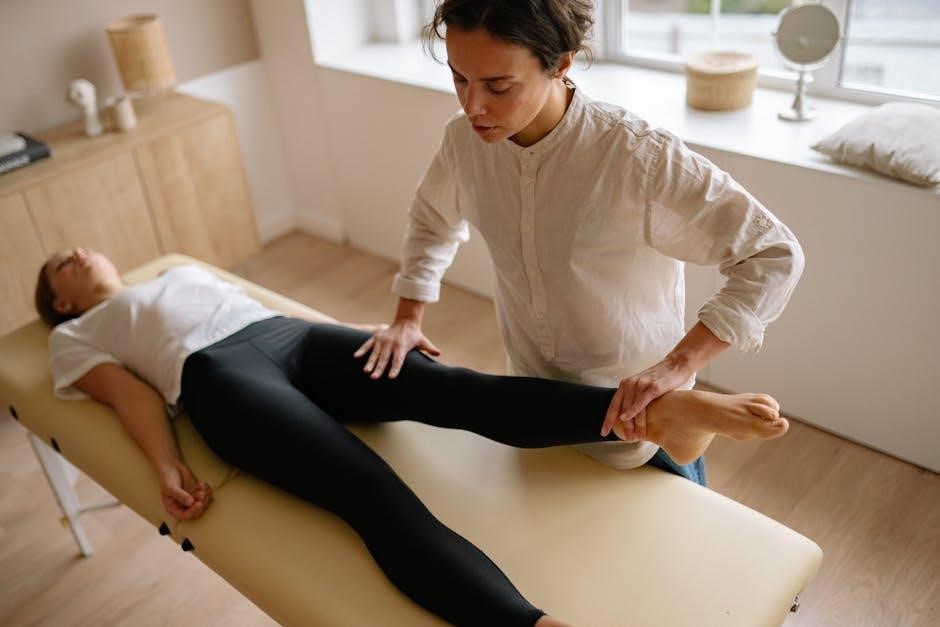Diastasis recti is a common postpartum condition where abdominal muscles separate, causing core instability. Physiotherapy plays a crucial role in restoring strength and improving posture effectively.
1.1 Definition of Diastasis Recti
Diastasis recti is a condition characterized by the separation of the abdominal muscles, specifically the rectus abdominis, along the linea alba. This gap can occur during or after pregnancy, creating a visible bulge in the abdominal wall. It affects core stability and posture, often requiring targeted physiotherapy exercises to restore muscle integrity and functional strength.
1.2 Causes and Risk Factors
Diastasis recti often occurs during or after pregnancy due to abdominal muscle strain. Multiple pregnancies, heavy lifting, and intense exercises can exacerbate the condition. C-section deliveries, weak core muscles, and poor posture are additional risk factors. Postpartum women, particularly those over 35, are more susceptible. These factors weaken the linea alba, leading to abdominal separation and core instability.
- Pregnancy and childbirth
- Heavy lifting or high-pressure exercises
- Weak core or pelvic floor muscles
- Multiple pregnancies or C-section deliveries
1.3 Importance of Physiotherapy in Management
Physiotherapy is essential for managing diastasis recti, focusing on restoring core strength and improving posture. It addresses muscle imbalances, enhances pelvic floor engagement, and promotes proper breathing techniques. Through tailored exercises like deep core activation and abdominal bracing, physiotherapy helps close the abdominal gap, preventing further separation. Regular sessions also reduce back pain and improve overall stability, making it a non-invasive and effective solution for postpartum recovery.
- Restores core strength and stability
- Improves posture and reduces back pain
- Enhances pelvic floor muscle engagement
- Prevents further abdominal separation
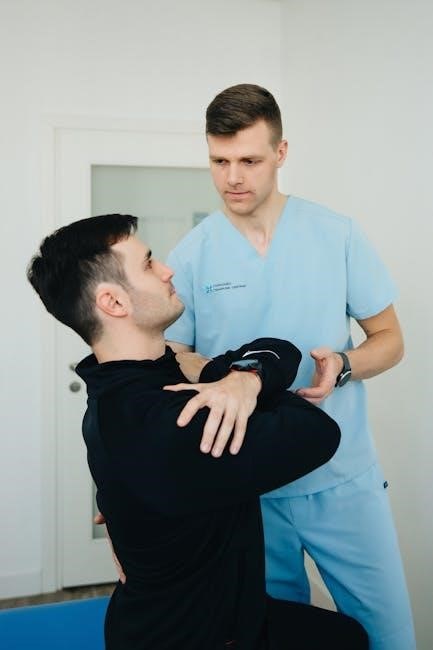
Best Physiotherapy Exercises for Diastasis Recti
Effective physiotherapy exercises for diastasis recti focus on core strengthening and stability. Techniques like pelvic tilts, abdominal bracing, and deep core activation help restore muscle integrity and improve posture.
2.1 Pelvic Tilts on Hands and Knees
Pelvic tilts on hands and knees strengthen the deep core muscles, improving posture and reducing diastasis recti. Start on all fours, engage your core, and tilt your pelvis backward, flattening your lower back. Hold for 5 seconds, repeat 10-15 times. This exercise promotes abdominal muscle integration and stability, essential for postpartum recovery and core rehabilitation.
2.2 Abdominal Bracing Techniques
Abdominal bracing involves engaging the transverse abdominis muscle to stabilize the core. Lie on your back with knees bent, inhale deeply, then exhale while drawing your belly button toward your spine. Hold for 5-10 seconds, repeat 10-15 times. This technique strengthens the deep abdominal muscles, improving spinal stability and reducing diastasis recti symptoms. Practice regularly to enhance core strength and posture.
2.3 Bird Dog Exercise
The Bird Dog Exercise strengthens core muscles and improves posture. Start on hands and knees, engage your core, then extend one arm and the opposite leg. Hold for 5-10 breaths, repeat 5-10 times on each side. This exercise enhances spinal stability and reduces diastasis recti by targeting the deep abdominal and pelvic floor muscles, promoting better core engagement and overall stability.
2.4 Bent Knee Fall Outs
Bent Knee Fall Outs target the transverse abdominis muscle, aiding in core stability. Lie on your back with knees bent and feet flat. Engage your core, then slowly lower your knees outward without arching your back. Hold for 5 seconds, return to the starting position, and repeat 10-15 times. This exercise strengthens the deep abdominal muscles, improving posture and reducing diastasis recti symptoms effectively.

Role of Breathing in Diastasis Recti Rehabilitation
Proper breathing techniques are crucial in diastasis recti rehabilitation, engaging the transverse abdominis muscle to stabilize the core and support healing effectively. They enhance core stability and promote healing when integrated into daily exercises.
3.1 Umbrella Breathing with Kegel Exercises
Umbrella breathing combined with Kegel exercises strengthens the transverse abdominis and pelvic floor muscles, enhancing core stability. This technique involves exhaling deeply while drawing the abdomen inward, followed by Kegel contractions to engage the pelvic floor. Regular practice improves postural alignment and reduces diastasis recti separation, promoting a stronger, more stable core during postpartum recovery and beyond.
3.2 Deep Core Activation Techniques
Deep core activation techniques target the transverse abdominis muscle, essential for stabilizing the spine and pelvis. These exercises involve lying on your back with knees bent, placing hands on the abdomen, and engaging the core without using abdominal muscles. Gentle contractions are held for 3-5 seconds, repeated for 10-15 repetitions. This strengthens the internal core, improving posture and reducing diastasis recti separation effectively.
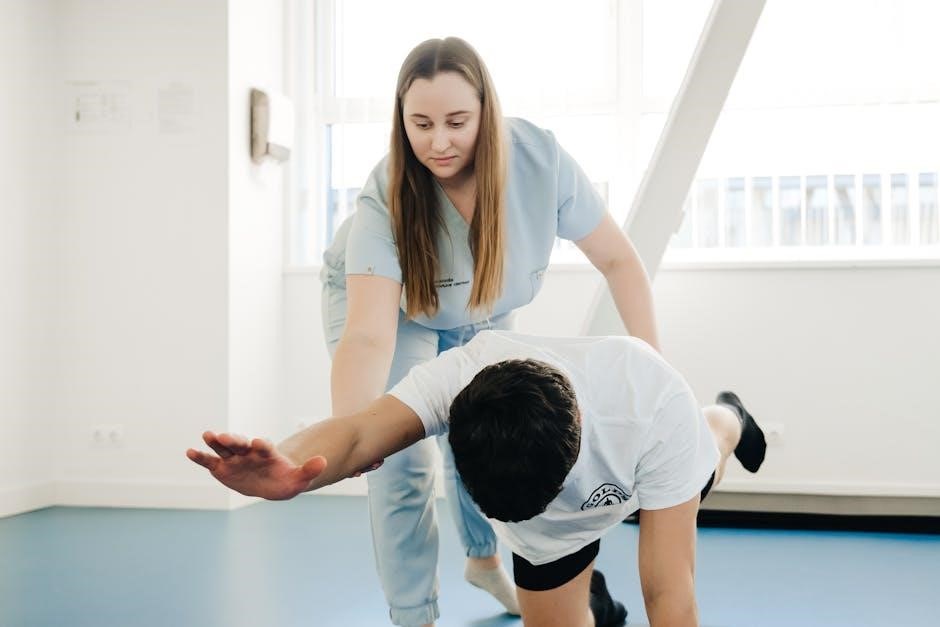
Progression of Exercises for Advanced Healing
Advanced exercises like heel slides and glute bridges strengthen core stability, promoting deeper healing and improving overall core function for individuals with diastasis recti.
4.1 Heel Slides and Toe Taps
Heel slides and toe taps are advanced exercises that target the core and pelvic floor muscles. These movements improve flexibility and strength, aiding in postpartum recovery. Performing heel slides involves slowly sliding one heel toward the body while maintaining a neutral spine, enhancing lower abdominal engagement. Toe taps strengthen the transverse abdominis, promoting better posture and reducing diastasis recti severity. These exercises are effective for advanced healing and core stability.
4.2 Glute Bridges for Core Stability
Glute bridges are effective for strengthening the glutes and improving core stability. Lie on your back with knees bent, feet flat, and slowly lift your hips while engaging your transverse abdominis. This exercise enhances pelvic floor muscle activation without straining the abdomen, making it ideal for advanced diastasis recti recovery. Regular practice improves posture and reduces lower back pain, promoting overall core strength and stability effectively.
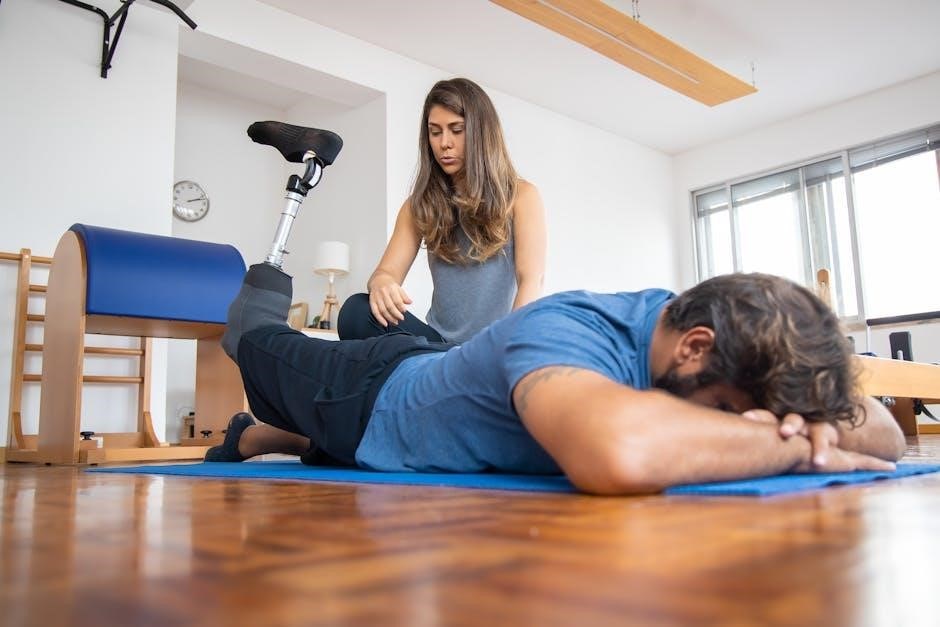
Preventing Worsening of Diastasis Recti
Preventing diastasis recti worsening involves avoiding heavy lifting, maintaining proper posture, and using correct body mechanics. These strategies reduce abdominal pressure and protect core integrity effectively.
5.1 Avoiding Heavy Lifting and High-Pressure Exercises
Avoiding heavy lifting and high-pressure exercises is essential to prevent worsening diastasis recti. Activities that strain the abdominal wall, such as intense crunches or lifting heavy objects, can further weaken the connective tissue. Instead, focus on gentle, modified core exercises and use assistive devices or belts to support your core during daily tasks. Proper body mechanics and posture can also reduce abdominal pressure and promote healing.
5.2 Proper Posture and Body Mechanics
Maintaining proper posture and body mechanics is crucial for managing diastasis recti. Poor posture can strain the abdominal wall, worsening the separation. Practice standing tall with shoulders back and pelvis in neutral alignment. When lifting, bend at the knees and engage your core to avoid putting pressure on the abdominal muscles. Awareness of posture during daily activities can significantly reduce strain and support healing.
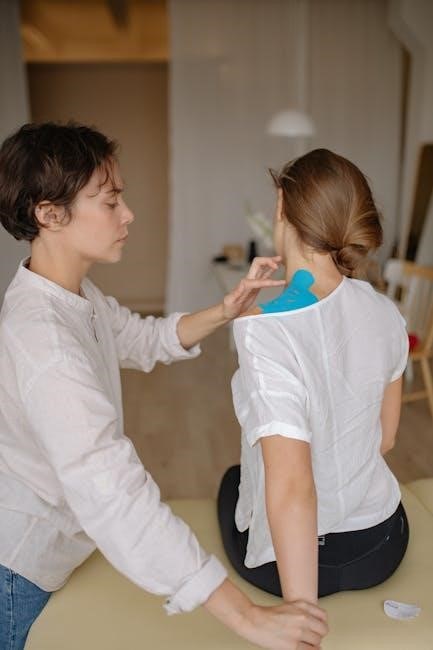
Success Stories and Case Studies
Many individuals, including celebrities like Ciara, have successfully managed diastasis recti through targeted exercises and physiotherapy. Real-life recoveries highlight the effectiveness of core-strengthening routines in improving symptoms.
6.1 Real-Life Examples of Recovery
Women with diastasis recti have shared inspiring recovery journeys. One mother achieved significant core strength improvement through consistent pelvic tilts and umbrella breathing exercises. Another individual regained posture stability by incorporating abdominal bracing and glute bridges into her routine. These success stories demonstrate how targeted physiotherapy exercises can effectively heal abdominal separation and restore functional core stability, empowering individuals to return to active lifestyles with confidence.
6.2 Celebrities Like Ciara and Their Experiences
Ciara, a renowned singer, openly discussed her journey with diastasis recti after pregnancy. She emphasized the importance of core-strengthening exercises like abdominal bracing and pelvic tilts to aid her recovery. Her story highlights how targeted physiotherapy can help restore core stability and improve posture. Celebrities sharing their experiences raise awareness and inspire others to seek effective treatments for this common postpartum condition, proving recovery is achievable with the right approach.
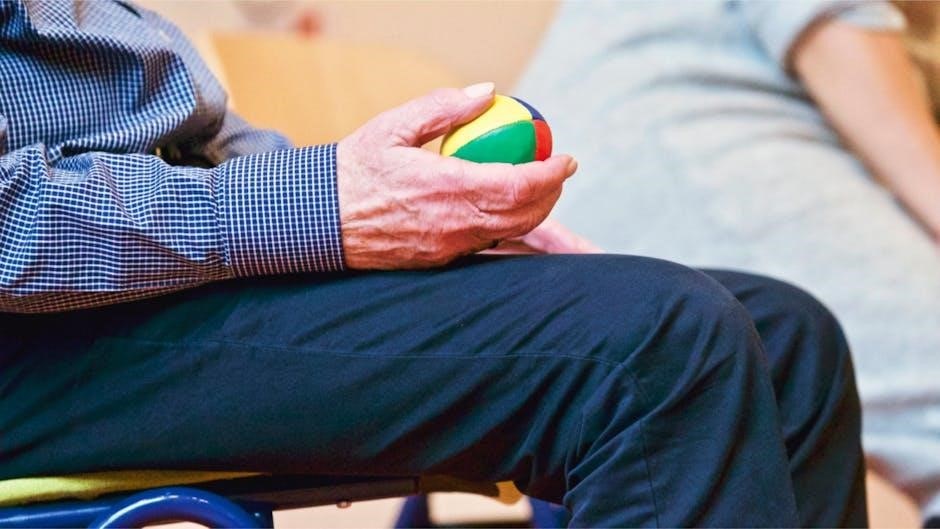
When to Consult a Physiotherapist
Consult a physiotherapist if the abdominal gap exceeds two fingers or symptoms like pain persist. They assess severity and create personalized plans to repair and strengthen core muscles effectively.
7.1 Signs That Indicate Professional Help is Needed
If the abdominal gap exceeds two fingers or persists beyond postpartum recovery, seek professional help. Symptoms like chronic pain, difficulty engaging core muscles, or associated pelvic floor issues warrant physiotherapy consultation. A physiotherapist will assess severity and tailor exercises to address specific needs, ensuring effective healing and core stability.
7.2 How Physiotherapists Assess and Treat Diastasis Recti
Physiotherapists assess diastasis recti through clinical examination, including palpation of the abdominal gap and evaluation of core engagement. Treatment involves personalized exercises targeting transverse abdominis and pelvic floor muscles. Techniques like deep core activation, breathing exercises, and gentle movements are used to restore stability. Progress is monitored, and exercises are progressively intensified to ensure optimal healing and functional recovery, addressing both symptoms and underlying muscle imbalances effectively.
Consistent practice of core-strengthening exercises and proper posture helps manage diastasis recti long-term, promoting sustained stability and reducing recurrence, ensuring a stronger, healthier core for years to come.
8.1 Summary of Key Exercises and Techniques
Key exercises include pelvic tilts, abdominal bracing, bird dog, bent knee fallouts, heel slides, and glute bridges. These techniques strengthen core muscles, improve posture, and enhance stability. Breathing exercises, like umbrella breathing with Kegels, and deep core activation are essential for rebuilding abdominal strength. Consistent practice of these techniques supports long-term recovery and prevents recurrence, helping individuals regain functional strength and confidence in daily activities and movements.
8.2 Maintaining Core Strength for Future Prevention
Maintaining core strength is vital for preventing diastasis recti recurrence. Regular exercises like pelvic tilts, abdominal bracing, and deep breathing help sustain muscle integrity. Incorporating daily routines, such as proper posture and mindful movements, reduces strain on the abdominal wall. Strengthening the transverse abdominis and pelvic floor muscles through consistent practice promotes long-term stability and supports overall core health, ensuring lasting results and preventing future complications.
